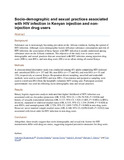| dc.description.abstract | Background
Substance use is increasingly becoming prevalent on the African continent, fueling the spread of HIV infection. Although socio-demographic factors influence substance consumption and risk of HIV infection, the association of these factors with HIV infection is poorly understood among substance users on the African continent. The objective of the study was to assess socio-demographic and sexual practices that are associated with HIV infection among injection drug users (IDUs), non-IDUs, and non-drug users (DUs) at an urban setting of coastal Kenya.
Methods
A cross-sectional descriptive study was conducted among 451 adults comprising HIV-infected and -uninfected IDUs (n = 157 and 39); non-IDUs (n = 17 and 48); and non-DUs (n = 55 and 135); respectively at coastal, Kenya. Respondent driven sampling, snowball and makeshift methods were used to enroll IDUs and non-IDUs. Convenience and purposive sampling were used to enroll non-DUs from the hospital’s voluntary HIV testing unit. Participant assisted questionnaire was used in collecting socio-demographic data and sexual practices.
Results
Binary logistic regression analysis indicated that higher likelihood of HIV infection was associated with sex for police protection (OR, 9.526; 95% CI, 1.156-78.528; P = 0.036) and history of sexually transmitted infection (OR, 5.117; 95% CI, 1.924-13.485; P = 0.001) in IDUs; divorced, separated or widowed marital status (OR, 6.315; 95% CI, 1.334-29.898; P = 0.020) in non-IDUs; and unemployment (OR, 2.724; 95% CI, 1.049-7.070; P = 0.040) in non-drug users. However, never married (single) marital status (OR, 0.140; 95% CI, 0.030-0.649; P = 0.012) was associated with lower odds for HIV infection in non-drug users.
Conclusion
Altogether, these results suggest that socio-demographic and sexual risk factors for HIV transmission differ with drug use status, suggesting targeted preventive measures for drug users. | en_US |

